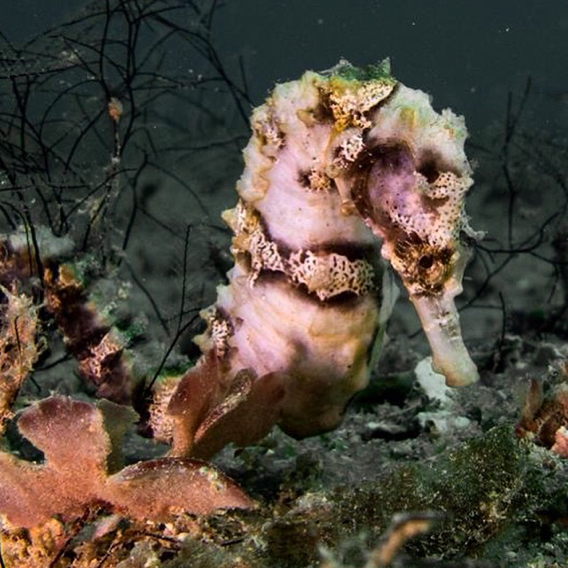Seahorse identity crisis?!?

iSeahorse's featured seahorse for August is… drumroll please... a mystery! It was found at Mafia Island Marine Park off the coast of Tanzania by two divers from Mafia Island Diving (posted to iSeahorse under the username mafia-island-diving). There have been plenty of Hippocampus histrix (thorny seahorse) sightings in the area, but that’s not the species seen here. While this fish is undeniably dapper, that’s where the certainty ends. At this point, our best guess is H. kuda (spotted seahorse), but coming to this conclusion hasn’t been easy as there are four main challenges.
Challenge #1: As vital as photographs are to seahorse research, there is only so much that a single snapshot can reveal. Riley Pollom, an IUCN Seahorse, Pipefish & Stickleback Specialist Group member, weighed in on the situation. “I would say that this is H. kelloggi given the shape of the coronet and the eye spines,” said Pollom. “I can’t be sure with that photo though.” The photo shows only one angle of the animal, and parts of its body are obscured by the environment. However, the pattern and colour are showcased quite marvelously.
Challenge #2: In many animal species, colour and pattern could be enough to identify an individual specimen. Unfortunately, seahorses aren’t so simple, especially since they can change colour, and some can even grow fronds to match their habitat. “I have seen that colour pattern on H. trimaculatus (three-spot seahorse) quite often,” said Pollom. “But that species isn’t known from there and is typically deeper.”
Challenge #3: Just because a species hasn’t been found living in an area, doesn’t mean it doesn’t live there - it just might not have been discovered there yet! iSeahorse plays a role in matching geographic locations to Hippocampus species. Lily Stanton, a Project Seahorse biologist, was torn between H. alatus and H. borboniensis. “The problem is that H. alatus is not known to occur on the east coast of Tanzania, and is predominantly distributed in Southeast Asia.”
Challenge #4: Brace yourself for some Hippocampus drama! H. alatus and H. borboniensis no longer exist. Don’t worry, the seahorses aren’t extinct, just the latin names. Hippocampus alatus is now referred to as H. spinosissimus (hedgehog seahorse), while H. borboniensis is considered to be H. kuda (spotted seahorse). “After much deliberation, I decided on with H. kuda,” said Stanton. “I thought it seemed to closely resemble H. borboniensis, which has been synonymized with H. kuda based on the taxonomic revision of seahorses by Lourie et al. 2016.” In the revision, nine former species were lumped with H. borboniensis into the kuda group. Stanton added,“I did, however, feel that it closely resembled H. alatus as well, which has been synonymized with H. spinosissimus.”
Dr. Sara Lourie, the Project Seahorse research associate involved with the revision, is a Hippocampus taxonomy expert. She agreed with Stanton that the fish-of-the-month closely resembles H. borboniensis, leading to a tentative diagnosis of H. kuda. “The bottom line is that H. borboniensis is a poorly understood species, as is H. alatus, neither of which are currently listed as valid,” said Lourie. In the revision, many species that were historically distinct from one another became synonymous. At present, there are 41 recognized seahorses, but that number is subject to go up or down as we learn about Hippocampus genetics, appearance, range and behaviour. The kuda group could potentially be re-divided and re-named, so if H. kuda actually represents several species, to call the mystery fish H. kuda might not be telling the full story. “I do think that iSeahorse has the potential to be a great source of information to learn more about species diversity and distribution,” said Lourie.
Part of the reason that seahorse identification, and species identification in general, is so taxing is that taxonomy itself is constantly in flux. Even what makes a species a species is subjective. Species can be designated based on different classification systems, including physical traits, the ability to produce viable offspring, and similarities at a molecular level. Scientists can debate the definition of species til the sea cows come home, but at the end of the day, there is no easy answer. Taxonomy can be messy. There is no easy answer to August’s featured seahorse conundrum, either. For now, let’s go with H. kuda, shall we?
More information:









Comentarios
@rileypollom , Hi thanks for posting this, it was really interesting. I didn't realise that naming Seahorses was so involved as well as the number of different types, it really was an eye opener for me. Everyone at iSeahorse certainly have their work cut out for them. Thanks Ken
Thank you for this wonderful write up - we really appreciate the assistance and excitement! On Mafia we find a crazy number of unidentifiable creatures - is it not possible that it could be a new species? or cross-breeding of two species? Hippocampus Mafioso ;-)
Añade un comentario